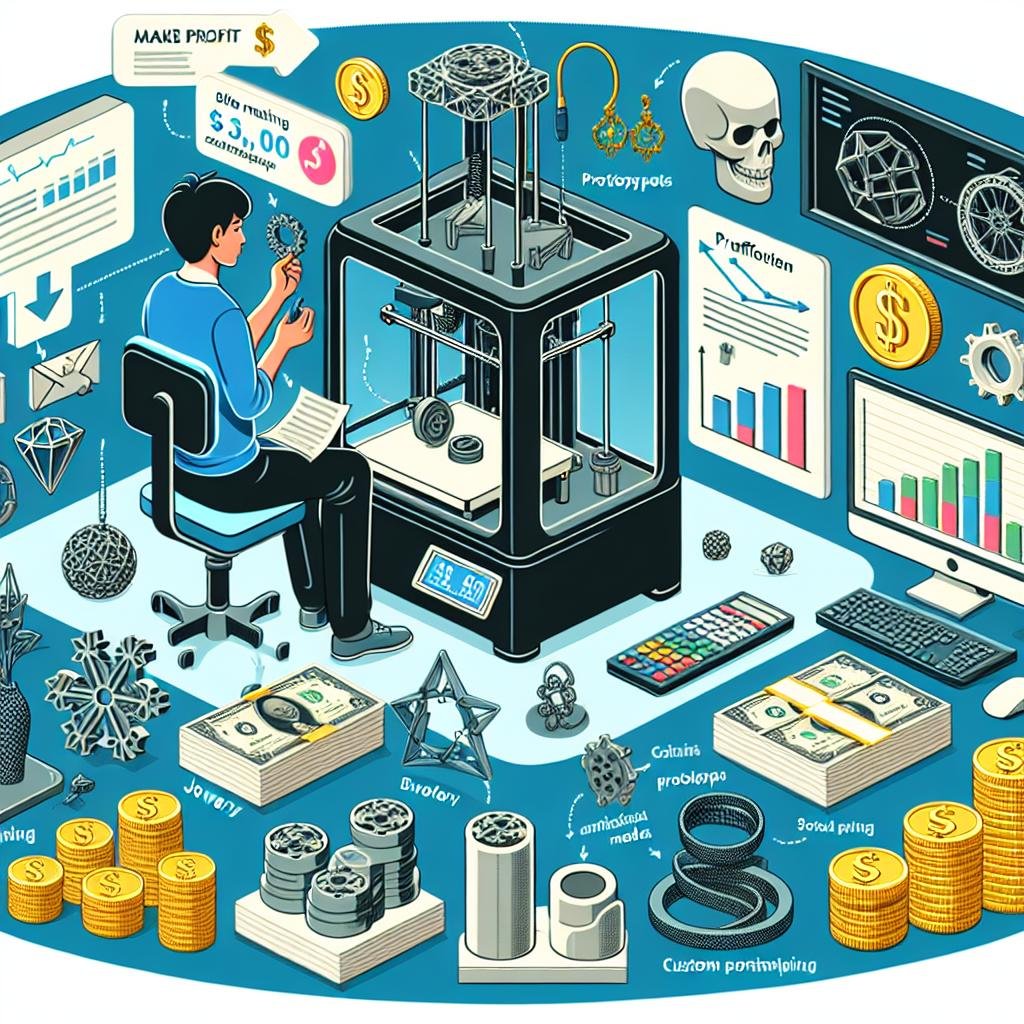In a world where imagination meets technology, 3D printing stands as a dazzling bridge between dreams and reality. The hum of a 3D printer brings to life a symphony of creativity, crafting everything from bespoke jewelry to life-saving medical models with intricate precision. As a 3D printing enthusiast, you’ve probably filled your space with mesmerizing creations, each piece a testament to your skill and passion. But what if your hobby could evolve into a thriving source of income? Imagine turning your ingenious designs into dollars, your filament into funds. Welcome to the exciting world of monetizing your 3D printing skills—a place where innovation and entrepreneurship go hand in hand, and where your next print could be the start of something extraordinary. Let’s embark on this journey together, transforming your craft into profit, one layer at a time.
Navigating the Marketplace: Where to Sell Your 3D Creations
Choosing the right platform to market your 3D-printed creations is crucial. Before diving in, consider factors like audience, fees, and ease of use. Major online marketplaces such as Amazon, Etsy, and eBay are popular choices. These platforms offer a broad reach and a ready customer base, but come with their own set of fee structures and listing requirements. Niche platforms like Shapeways and Sculpteo focus specifically on 3D-printed items, attracting a more targeted audience and usually providing additional resources like printing and shipping services.
Look beyond traditional e-commerce sites and explore specialized communities and forums.
- Thingiverse – A hub for sharing and selling 3D designs with a DIY community vibe.
- MyMiniFactory – Focuses on curated, high-quality printable designs.
- CGTrader – A marketplace styled for professional-grade 3D models.
Each of these platforms has its own unique selling points, so choose one that aligns best with your target audience and business goals. For instance, Thingiverse might be ideal if you’re catering to hobbyists, while CGTrader may better serve professional designers and businesses looking for high-end models.
| Platform | Key Feature | Commission |
|---|---|---|
| Amazon | Massive Audience | 8-15% |
| Etsy | Artisanal Focus | 5% + Listing Fees |
| Shapeways | Turnkey Solutions | 3.5% |
| CGTrader | Professional Quality | 30% |

Crafting Compelling Designs: Turning Ideas into Profits
When it comes to transforming your 3D printing prowess into a profitable venture, the possibilities are as boundless as your imagination. Personalization is a lucrative niche, whether it’s custom-made phone cases, intricate jewelry, or bespoke home decor items. Offering unique, made-to-order products can set you apart in a crowded market. Engage potential clients through platforms like Etsy, Shapeways, or even your own online store. Integrate social media to share your creations, craft compelling stories, and illustrate the journey from concept to creation, captivating a broad audience.
Another appealing strategy is collaborative projects. Partner with designers, architects, or engineers who lack 3D printing expertise but have ideas that demand physical manifestation. You could also explore educational workshops or courses to teach others about 3D printing, providing both in-person sessions and online courses. Additionally, consider prototyping services for startups and inventors, helping them bring their ideas to life with precision and flair. Here’s a quick snapshot of potential revenue streams:
| Service | Potential Earnings |
|---|---|
| Custom Product Sales | $20-$150 per item |
| Workshop Fees | $50-$200 per session |
| Prototyping Services | $500-$3000 per project |

Building a Brand: Marketing Strategies for Your 3D Printing Business
Embarking on your 3D printing venture is akin to sculpting a masterpiece—every detail matters. To carve out a strong brand, consider a holistic marketing strategy that engages and inspires your target audience. Use social media platforms to showcase your creations, leveraging visually captivating posts and engaging stories to keep your audience hooked. Create a portfolio website featuring a blog section where you dissect the intricacies of your projects. This not only positions you as an expert but also attracts organic traffic to your site. Work on SEO to ensure your website appears in the top search results. Next, harness the power of email marketing to build and maintain relationships. Offer subscribers exclusive content, such as printable files or design tips, to keep them coming back for more.
- Social Media: Post visually appealing photos and stories
- Portfolio Website: Include a blog to drive organic traffic
- SEO: Optimize your content for search engines
- Email Marketing: Engage subscribers with exclusive content
Running promotions and partnering with influencers can drastically enhance your brand visibility. Limited-time deals, referral programs, and contests can generate excitement and encourage user-generated content. Collaborate with influencers who resonate with your brand ethos; they can bring your creations to a wider audience. Don’t overlook local businesses—networking within your community can open doors you never imagined. Offer to create custom promotional items for local events or businesses, in exchange for a shout-out or a small fee. For more analytical insights, use tools like Google Analytics to track user behavior on your site and adjust your strategy accordingly. This will help you identify what’s working and what needs tweaking.
| Tool | Purpose |
| Google Analytics | Track user behavior |
| Hootsuite | Schedule social media posts |
| Mailchimp | Manage email marketing |

Enhancing Skills and Services: Investing in Continuous Improvement
Mastering the art of 3D printing opens up endless avenues for business growth. To thrive, it’s essential to invest in continuous improvement. Here are some key strategies to elevate your craft:
- Embrace New Technologies: Stay updated with the latest in 3D printing software and hardware. Integrate state-of-the-art tools to enhance precision and efficiency.
- Expand Your Knowledge Base: Attend workshops, webinars, and professional courses. Learn from the pioneers in the field to refine your techniques.
- Experiment and Innovate: Dedicate time to experiment with different materials and printing methods. Encourage creativity and push the boundaries of conventional designs.
It’s also vital to enhance service offerings to cater to a broader audience. Consider these actionable steps:
- Customized Solutions: Provide bespoke designs tailored to specific client needs, adding a personal touch to your service.
- Client Education: Offer training sessions or downloadable guides to help clients utilize the full potential of their 3D-printed products.
- Responsive Support: Implement a robust support system to solve any client issues promptly, boosting customer satisfaction and loyalty.
| Action | Benefit |
|---|---|
| Invest in New Technologies | Higher precision, faster production |
| Expand Knowledge | Stay ahead in the industry |
| Innovate | Diversify and improve products |
Q&A
Q&A: How to Monetize Your 3D Printing Skills
Q: How do I sell the 3D-printed items I create?
A: Great question! Firstly, do a bit of market research to figure out what people are looking for—unique household items, custom jewelry, cosplay accessories, or even specialized parts for gadgets. Then, choose a platform to sell your creations. Etsy, Amazon, and your own online store can be great places to start showcasing your 3D-printed masterpieces. High-quality photos and detailed descriptions are your best friends here!
Q: Can I offer 3D printing services instead of selling physical items?
A: Absolutely! You can market yourself as a 3D printing service provider. This means clients send you their designs or ideas, and you bring them to life using your 3D printer. Websites like 3D Hubs, Shapeways, and even Fiverr allow you to list your services. Tailor your offerings to niches you’re passionate about—be it prototyping for startups, educational models for schools, or artistic creations for enthusiasts.
Q: How do I price my 3D-printed items or services?
A: Pricing can be a bit of a balancing act! Start by calculating the cost of materials, time spent printing, and any additional post-processing work. Don’t forget to add a margin for your skills and creativity! Research what similar items or services are priced at to ensure you stay competitive. For bespoke services, you might also consider tiered pricing based on complexity and turnaround time. Remember, your time and expertise are valuable!
Q: What if I’m not that confident in my design skills yet?
A: No worries at all! Everyone starts somewhere. While you’re honing your design skills, you can still earn by printing and selling open-source designs. Websites like Thingiverse and MyMiniFactory offer a plethora of free designs. You can print these, potentially modify them slightly, and sell them with proper credit to the original designers. Simultaneously, invest some time in learning design software like TinkerCAD, Blender, or Fusion 360. Practice makes perfect!
Q: Are there other avenues to make money with 3D printing?
A: Oh, definitely! Think beyond the traditional. Consider offering workshops or online courses to teach others about 3D printing. You could host community events or maker-space sessions. Another exciting avenue is renting out your 3D printer to local businesses or hobbyists who don’t have access to one. Also, partnering with artists, inventors, and educators can open new streams of income. The possibilities are practically endless!
Q: How do I market my 3D printing business effectively?
A: Visibility is key! Leverage social media platforms like Instagram, Pinterest, and YouTube to showcase your work. Create engaging content, such as time-lapse videos of your printing process or tutorials on how to assemble printed parts. Consistent posting with the right hashtags can drive traffic to your store or service page. Don’t underestimate the power of word-of-mouth; happy customers can become your best marketers. Participating in local fairs, trade shows, or even joining online 3D printing communities can also help you build a loyal customer base.
Q: What’s the most important thing to remember while monetizing my 3D printing skills?
A: Love what you do! Passion is infectious and will reflect in your creations and business interactions. Stay curious, keep learning, and don’t be afraid to experiment. The world of 3D printing is ever-evolving, offering new opportunities at every turn. Happy printing!
The Conclusion
And there you have it, the magical roadmap to turning your 3D printing skills into a thriving treasure trove of opportunities! From crafting one-of-a-kind creations that spark joy, to diving into the endless ocean of digital designs and services, your potential is as limitless as your imagination. So, fire up that filament, let your creativity flow, and may your entrepreneurial journey be as solid and vibrant as the masterpieces you print. Happy making, and may your profits soar as high as your dreams! 🌟✨

